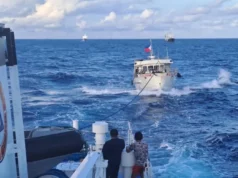Water Water Every Where No Water To Drink: Fiji’s fight to withstand climate change
By Dave Barnette
On the map, bird-shaped Vorovoro Island can be found flying just a little north of Vanua Levu, one of Fiji’s two mainland islands. It can also be found inked on the pale skin just below my 21-year-old daughter’s rib cage. Debates are ongoing as to how long the 200-acre island will remain above water and on maps, but there was little debate last year about its permanence on Sibley’s body; she was resolute. She said it would feature an outline of the volcanic island’s four peaks. I heard her say its text would be a phrase in Fijian that translated roughly to “one plus one equals one,” a quote from the chief of the tribe she had lived and worked with for six weeks as part of a study-abroad program. She wanted to go there again after graduating from Auburn University this year, to work more with the tribe. “For a few months,” she said. “Maybe longer.”
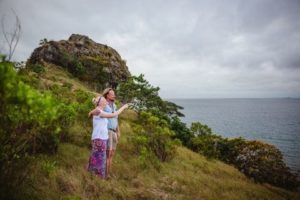
While Sibley talked about the possibility of the world losing an island, what I heard was that I was losing my daughter to a culture and a cause I didn’t understand. My father’s views were more akin to Archie Bunker’s than to, say, Al Gore’s, and while I liked to think of myself as a lover of nature who cares about the needs of others, I am also that guy who drives solo in an eight-seater Sequoia and still hasn’t picked up those recycling bins from the city. My visit to the front line of climate change wasn’t motivated by concern for dying coral reefs or shrinking Pacific islands. I went because of the threatened status of my relevance to my child.
The writer, right, presents a gift to Tui Mali, chief of the Mali tribe, during a welcoming ceremony. (Laura Pittman/For The Washington Post)
Sibley meets our plane in Labasa, and we board a small skiff on a river nearby: Sibley; several members of the Mali tribe; Jane, whom I just married two weeks earlier; and me. Sibley has high hopes for my third marriage: Jane has climbed Kilimanjaro. Jane recycles. The two of them have gotten me to watch a few episodes of “The Blue Planet.”

Forty-five minutes later, we’re approaching Vorovoro. Unlike the jewel-toned Fiji seen in resort ads, the landscape is darkly feathered with coconut palms and bronzed with rain-carved stone as we near the backside of the island’s avian shape. As we round the western wingtip, the sunnier northern face comes into view, a rocky outcropping with the stern brow of an Easter Island carving. We make landing in one of the sandy coves sheltered by the island’s wings, and that sternness gives way to a greeting line of tribe members mixed with students participating in the same study-abroad program that brought Sibley here last year. Helping the Mali tribe diversify its livelihood through similar educational programs and eco-tourism is the focus of Bridge the Gap: Vorovoro Island, the organization she’s working with now.
Sibley has shown me satellite views of the Cakaulevu Reef, and how even small changes in its health, along with commercial overfishing, require longer and more-unprofitable trips by Mali fishermen. She’d point to a patchwork of mainland fields where Auburn is working with farmers to move toward crop rotation as a way to survive changes in weather patterns that frustrate their traditional monoculture. Fiji’s vulnerability to rising sea levels and increasingly intense cyclones has brought the island nation attention on a big scale — headlining last year’s U.N. climate-change conference, for instance — and yet it’s on a smaller scale that the threat becomes palpable. On a 200-acre island, a rising tide is an existential threat. There’s no room for denial, little higher ground to escape to and few resources to work with. As Sibley says, the Fijians are at the end of the line.
When Sibley talks about “the Fijians,” she’s talking specifically about those who live as part of a traditional tribe on one of the archipelago nation’s smaller islands — more specifically, the Mali tribe, whose chief, Tui Mali, is working to find sustainable replacements to tribal livelihoods eroded by waterborne challenges.
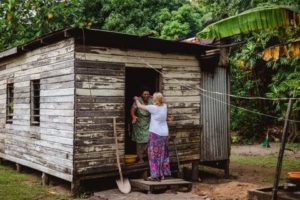
There’s a troubling duality to the role of water for Tui Mali’s people. Seawater is increasingly a rising, warming threat, while drinking water has become increasingly scarce. Catchment systems have been built in response to changes in rainfall; on tiny Vorovoro, which has no available source of groundwater, it’s a matter of preserving habitability. The ubiquitous Fiji-branded bottled water isn’t so ubiquitous here.
Drinking water, already precious, is ceremoniously so when used to prepare grog. Grog is the Fijians’ term for their ritual drinking of kava, a mildly narcotic beverage made from a dried root that’s pounded into a powder and then mixed with water until it’s the color of a failed chai. It’s a communal drink, earthy and surprisingly pleasant, like drinking a concoction of 97 percent unsweetened green tea and 3 percent Lortab. Once sunset’s last light sinks down behind the distant peak of Kia Island, the grog sessions begin and often go on for what feels like another full day.
Sibley and her friend Nemani, a cinnamon-goateed sugar-cane farmer, give me a crash course in grog etiquette: Always enter the grand bure, the village’s central pavilion, barefoot. Stoop as you walk in to show your efforts to lower yourself. Men sit cross-legged, women with both feet tucked to one side, and both sexes take care to never show the chief the soles of their feet. It’s a lot to learn after the flights and boat ride in, but they’re preparing me for the sevusevu, a Fijian tribal ceremony in which newcomers to a village will present the chief or an elder with a bundle of dried kava root and then be welcomed into the tribe. It’s a key-to-the-city sort of greeting, but from a village that has no doors to lock.
Near the front and center of the grand bure is a wooden post with a dark circle on it about two or three feet off the ground, as though someone had tried out a varnish. That’s where Tui Mali rests his head as he leans against it. Jane’s by my side — tonight I’ll be presenting and speaking for both of us — and I alternate between watching the chief and watching Sibley watching me. In the long litany of kava preparation, Tui Mali sometimes closes his eyes for a moment, but when I’m premature with my cobo — three cupped-hand claps to announce that I’m ready to crawl toward him with my gift — he’s quick to break into a smile. I glance over at Sibley, not unlike the way she might have looked toward me during a preschool play.
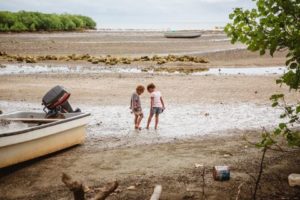
“You’re going to make mistakes,” she’d told me earlier during rehearsal, “but a little humility goes a long way with the chief.” Humility is not necessarily my strong suit, but it’s my lot for tonight as I finally cobo at the right time, crouch my 6-4 frame into an appropriately supplicant size and crouch on all fours — my Columbia shorts loin-wrapped in a knee-length sulu, no less — toward the man my daughter has quoted on her own flesh. Sibley and Nemani have propped a plywood cheat sheet up for me at the far end of the grand bure, just a few key Fijian prompts, but now as I try to coolly look past the chief’s smile and nod for my next line, I can’t quite make out the letters. There’s no breeze, and just as the temperature seems to rise by the second, particularly in the vicinity of my cheeks, Tui Mali leans forward from his post and whispers my next lines, a few words at a time, and I repeat them back to him. It reminds me more than a little of repeating vows at the church just a couple weeks before, trusting somehow that sincerity would inhabit the script. “Oh, vinaka, vinaka,” he says — thank you, thank you. (He really appreciates an honest effort, Sibley has told me.)
The next part of the sevusevu is supposed to be extemporaneous, some thought to offer the chief as a visitor from abroad. This is preferably something heartfelt, but I’d scripted that line, too, thinking there was no way I’d have anything to say from the heart so soon.
“About a year ago, my daughter came back to one home trying to explain to me how she was missing another home,” I say, “and now I’m beginning to understand how.” I’m an advertising guy by trade — I know how to address multiple targets at once. It was a line meant to show the chief I knew how much my daughter loved his island, to show her how much I wanted to understand why, and to show my new wife that I could hold my own, even when crawling in a sulu. The thing is, after the chief’s gracious prompts, after just one afternoon of seeing everyone work together on this island, I was beginning to mean what I said.
When it comes to climate change, the Mali’s life and lexicon don’t lend themselves much to debating anthropogenic vs. natural cause, or cyclical vs. trend.
“They have work to do” was how Sibley had put it to me, although she may have used a noun less delicate than work in the fevered pitch of conversations we had last year when she came back from that first trip to Fiji, the two of us on opposing couches in our living room. She talked about the climate. About rising waters.
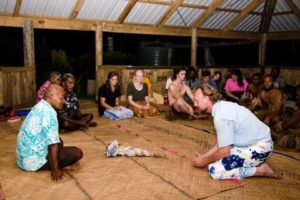
I talked about Parent PLUS college loans and starting salaries. She talked about how we, people in developed nations, made decisions to throw things away and live on borrowed time while they, people like the Fijians, had to live with the outcome. “They don’t have a choice, Dad.” It became clear to me that she and I were, for the first time, beginning to inhabit different sides in the case of We vs. They.
On the island, Sibley fits in remarkably well working alongside the Mali people. Even more remarkably, she fits in visually, despite the fact that she and I are, as we like to say, pigment-challenged. Barefoot in a T-shirt and long floral sulu, she walks like the Mali women. She’s embodying what, back in our polarized living room, I’d thought sounded a little like propaganda — the island’s lack of emphasis on possessions and outward beauty. Here, where there’s no right or wrong brand of shoe, no debating how much heel to wear, she walks with an island sway that seems to come from something in her bones, something that reminds me of the “Whale Rider” phase she went through when she was 8. As her mother and I debated whether it would be better for Sibley if we stayed together or divorced, she would watch “Whale Rider” over and over again. When we began speaking the language of parents who really need their children to just be happy with what’s been decided — You get two rooms now! Two Christmases! — she just sang the Maori chants memorized from the movie. It didn’t seem to matter whether the words made sense to her. She perfected the rhythm of a then-distant New Zealand tribe, now practically her neighbors in the South Pacific. At the time, her enthusiasm for the Maori seemed to be an anomaly; now, with her as my guide to this part of the world, it makes sense that her go-to movie would have been the story of Paikea, a girl who had to find the courage to replace her grandfather as the leader of her patriarchal tribe.
It’s the middle of the week, and we’re set to take the short boat ride from Vorovoro to Mali Island, home to three of the Mali tribe’s primary villages. Back home, Sibley told me that it wasn’t so long ago in tribal memory that the trip could be made on foot rather than by boat. I was skeptical. Later, I found a circa-1900 guide to the area’s islands that describes Mali and Vorovoro as joined “by a coral reef awash at low water.” I have been equally skeptical about the bond Sibley formed with the family who hosted her on Mali Island for three nights last year. Her study-abroad program traditionally refers to these hosts as the students’ Fijian family, and she had frequently spoken of her “Fijian mother” and, seemingly more frequently, her “Fijian father.” Now she, Jane and I were wading from the boat to Ligaulevu to meet them.
Ligaulevu is the largest of Mali Island’s three villages. It’s home to the tribe’s school, which is housed just a short walk inland in a few brightly colored wooden buildings that, along with some of the village’s homes, are arranged around a rectangular green. We cross a creek by walking along a narrow plank, and as I spot the chickens, the 500-foot wooded hill behind us, I say how much this reminds me of my grandparents’ farm in Kentucky. Maybe, I suggest to Sibley, that’s the key to Tui Mali’s “one plus one equals one,” finding the common ground, the connection. She says she’ll have to think about that.
It’s Sibley’s Fijian mother who comes to the door first, scanning our group until her eyes lock onto Sibley. She clasps her hands together against her chest and bites her lips to hold back, for just a few seconds, the outburst of a woman who sees before her a child she had thought was lost forever. Soon we’re all in an embrace, not a word spoken yet and not a dry eye among us. Her Fijian father is the first to speak. “We thought we’d never see her again.”
We visit by an ancient tree, a majestic ivi that once stood in the center of the village. Now it marks the water’s edge. Breaking the surface out past it are long, narrow ridges of stone at various distances. Like a tree’s rings, they’re spaced out in a record of time, the remains of three generations’ gradually retreating attempts at building a protective sea wall. Behind us is a village that has moved inland toward a steep, rocky rise and is running out of room.
We have only about an hour to visit on Mali Island before the weather and tides will make it difficult to get back to Voro¬voro. We all sit on the hull of an overturned boat and ask questions about one another’s lives. I don’t have much luck making advertising sound like a very worthy livelihood, and they don’t make a lot of progress in teaching me how to pronounce the names of their trees or explaining the history of rugby in their family tree. But the look on Sibley’s face tells me it doesn’t matter.
Sibley embraces her “Fijian mother,” with whom she stayed during her first time on the island. (Laura Pittman/For The Washington Post)
I am not the sort of person who would typically choose to spend seven or eight days sleeping in a thatch bure and dumping a half coconut shell full of wood shavings into a composting toilet after each use, but I am probably the sort who benefited most from the experience. The way time expands within days unplugged, a week on Vorovoro is long enough that you come to see a half-bucket-of-rainwater shower as a full-body luxury and plastic as unfathomably sinister.
Gone is the suburban wondering of what it is you want or crave; you are simply hungry or full, sleepy or can sleep no longer. It’s with considerable joy that you realize it’s time for your twice-weekly shower, fresh water captured in a catchment system Auburn students helped the Fijians build, drawn into a bucket you carry into the open-air shower stall on top of the big rock behind the village and pour into another bucket you hoist over your head and then use via the spigot on its bottom.
You like the way your body feels from this honest living on Vorovoro Island — the sweating, the sun, the lack of alcohol, the diet rich with frugality. You come to view a peanut butter sandwich like a prime cut of beef, but you’re careful to spread yours thinly, because that jar costs 18 Fijian dollars.
You wonder how someone on an island such as this earns $18, and you remember that’s why your daughter is here. You remember how one of the things she wept about on your couch 7,000 miles away was the way some Fijians would save their money until they could have enough to go into Labasa and order one golden-fried basket at Chicken Express.
You realize you’ve never been truly hungry.
You’re no longer afraid of the island’s crab-size spiders or prison-striped sea snakes, but one afternoon while walking on the beach, you’re startled by something coming toward you, levitating above the ground without wings or legs, and you’re briefly relieved to realize it’s only a plastic grocery bag animated by the breeze, until you pick it up and realize that here on Vorovoro, there is nothing you can do with it.
You can’t put it into another plastic bag and have a garbage truck haul it away. Down here, just as Sibley said, we’re at the end of the line. The bag is faded. There’s no way of knowing where it came from or who threw it out. But it’s here now, in my hand to deal with.
“The government came down here, to Mali, to see the quality of our beaches, how we keep things,” Tui Mali tells me during grog on one of our last nights on the island. “They walk on Mali’s beaches and they say, ‘Mali’s beaches are not good, too much trash,’ ” he says, closing his eyes for a moment. It’s as close to an environmental statement as I’ve heard from him all week during our long grog conversations. Each night when I approach the grog mat, I try to sit next to Sibley so we can visit, and each night the chief shakes his head and pats the seat-of-honor spot by him. “It’s okay,” she says. “He loves you.” I suggest maybe that’s a strong word for someone who’s known me for just less than a week. “No,” she says, with the authority she has on Vorovoro, “he loves you.”
She asks me more questions about my work and my writing than she probably ever had, and I tell her I finally have a theory on why the place has meant so much to her. It began forming that day when I realized she walked like a Fijian, and again the first time I saw the giant whale bones that stand in the middle of the village like a commemorative sculpture.
It was there again when she danced the meke, its chant so much like her childhood Maori. It was on her face when we all sat around the fire at night, dark volcanic forms rising behind us as the sound of waves hit the coral reefs that surround the island.
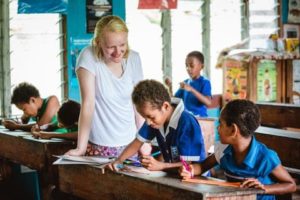
I tell her that maybe she liked the fact that on Vorovoro we are slowly returned to a kind of wisdom we had as kids, when we didn’t pretend to have all the answers. This isn’t an island bulwarked with answers and certainty; it’s honest about its vulnerability, its questions.
“Wow, Dad,” she says. “Yes. I think it’s something like that.” It’s with that encouragement, that watershed feeling, that I say I still don’t understand what Tui Mali’s math — one plus one equals one — means, that I want to understand since it matters enough to her to have it tattooed on her skin in the Fijian language.
Except that now I learn I’d had it wrong all these months. “My tattoo doesn’t say ‘one plus one,’ ” she says. Somehow I’ve been trying to solve the wrong problem all this time. Her tattoo contains the text of another favorite Tui Mali quote, one that’s not a statement but a wonder-filled question he asked once as they talked about the unlikely bond that had developed between her and the Mali people. It’s the same question I could ask now, about my relationship with my daughter, her relationship with this island, about the island’s uncertain fate. “Rawa va cava?” he asked her. How can it be?



